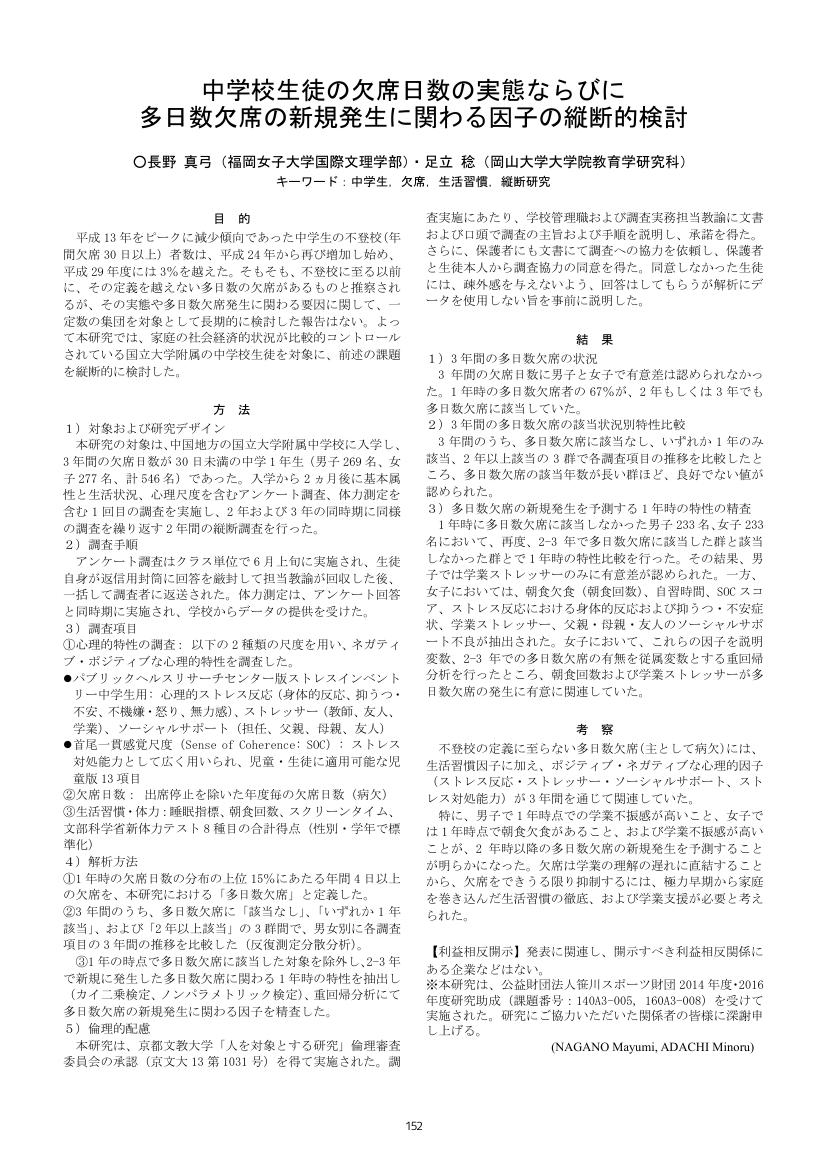1 0 0 0 OA 部活動の所属, 運動時間と学業成績の関連 ―中学2年生を対象とした検討―
- 著者
- 笹山 健作 野々上 敬子 多田 賢代 足立 稔
- 出版者
- 一般社団法人 日本学校保健学会
- 雑誌
- 学校保健研究 (ISSN:03869598)
- 巻号頁・発行日
- vol.56, no.4, pp.282-289, 2014-10-20 (Released:2023-04-07)
- 参考文献数
- 30
Objective: The purpose of this study was to examine the relationship between extracurricular activities, habitual exercise and academic achievement in junior high school students.Methods: The subjects were 627 junior high school students (330 boys and 297 girls). The subjects were divided according to their extracurricular activities such as sports and cultural clubs, or no activity. The number of hours per week the student exercises was surveyed by questionnaire. For academic achievement, the cumulative records from five subjects (Japanese, social studies, mathematics, science, English) and four subjects (music, art, physical education, and technical courses or home economics) were used. The academic achievement in each subject was rated on a 5-point scale.Results: Among the boys, the students involved in sports clubs had higher academic achievement compared to students who were not involved in any extracurricular activities (for the five subjects: sports clubs 16.9±4.4, no activity 14.1±4.5, p<0.05). Among the girls, students involved in both sports and cultural clubs had higher academic achievement compared to the students who were not involved in extracurricular activities (for the five subjects: sports clubs 18.0±4.1, cultural clubs 19.0±3.9, no association 16.3±4.4, p<0.05). With age as the controlled variable, positive correlation was shown between time spent playing sports and academic achievement in the five subjects (boys: r=0.182p<0.001, girls: r=0.125p<0.05).Conclusions: It was suggested that the academic achievement of male and female students involved in sports clubs was higher than that of students who were not involved in any activity, and there was a positive correlation between habitual exercise and academic achievement.
1 0 0 0 OA 中学校生徒の欠席日数の実態ならびに多日数欠席の新規発生に関わる因子の縦断的検討
- 著者
- 長野 真弓 足立 稔
- 出版者
- 一般社団法人 日本健康心理学会
- 雑誌
- 日本健康心理学会大会発表論文集 32 (ISSN:21898812)
- 巻号頁・発行日
- pp.152, 2019-09-28 (Released:2020-04-28)
1 0 0 0 OA 高校生を対象とした持久走に対する意識の変化:体力水準別での検討
- 著者
- 笹山 健作 西原 智子 大口 正行 芝田 孝 足立 稔
- 出版者
- 一般社団法人 日本体育学会
- 雑誌
- 体育学研究 (ISSN:04846710)
- 巻号頁・発行日
- pp.16045, (Released:2017-01-13)
- 参考文献数
- 29
This study examined changes in attitude toward endurance running in senior high school students with different levels of physical fitness, and this study assessed mood and calculation functions of students before and after endurance running. The participants were 250 senior high school students (119 boys and 131 girls). Endurance running was practiced at a slow pace (slow jogging pace; heart rate: 30-35 [15 s]; rate of perceived exertion (RPE): 11-13). Attitudes toward endurance running were assessed before and after the unit using a questionnaire. Attitudes toward endurance running, more specifically positivity and importance, were calculated in terms of a positive feeling score and cognitive score. In addition, negative attitudes toward endurance running were expressed as a negative feeling score. Changes in mood and calculation function were investigated in the participants and a control group. In the control group, comprising 75 boys and 41 girls, the changes of mood and calculation function were assessed before and after a health class. After the unit, the positive feeling and cognitive score increased significantly and the negative feeling score decreased significantly in both the lower and higher fitness groups. After endurance running, although levels of arousal in the control group were not increased in both boys and girls, arousal levels were increased significantly in both sexes in both the lower and higher fitness groups. The degree of mood change and the degree of attitude change were related significantly to the degree of change in perceived pleasure and the change in the positive feeling score for boys in the higher fitness group. Moreover, the degree of change in perceived pleasure and the degree of change in the positive and negative feeling scores were related significantly for girls in the lower fitness group. These results suggest that slow jogging in a unit, involving how students experience mood and calculation functions, leads to an increase in positive attitude toward endurance running. However, further investigation is necessary to examine the influence of slow jogging on mood and calculation functions, and the influence on attitude toward endurance running in this type of unit.
